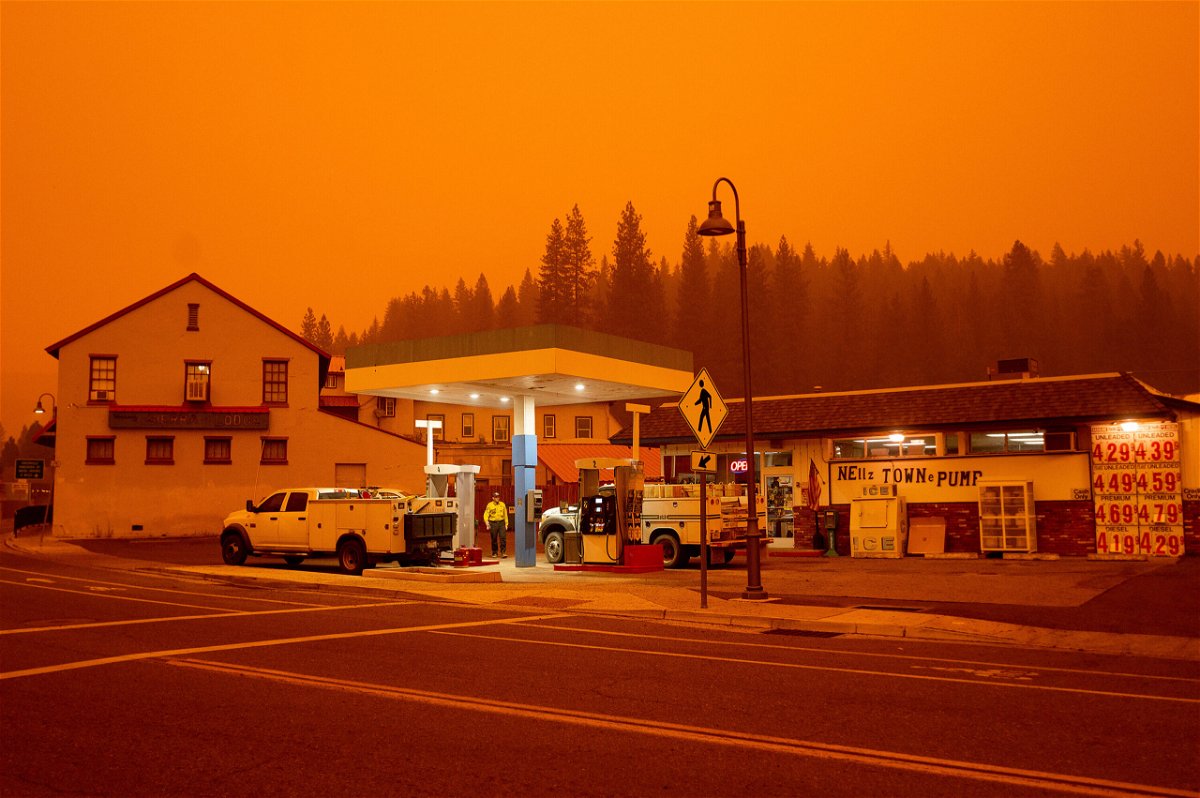With wildfires blazing across the West, more counties are declaring states of emergency

Firefighters gas up while battling the Dixie Fire in the Greenville community of Plumas County
By Aya Elamroussi, CNN
As dozens of wildfires burn across the West, officials declared additional states of emergency for counties in California and Nevada while the nation’s largest blaze in Oregon continued to swell Friday.
The Bootleg Fire in southern Oregon has scorched 401,601 acres since it was sparked by lightning on July 6, according to officials. It is 42% contained while more than 2,000 people in the surrounding areas remain under some form of an evacuation order.
“Our firefighters have put in an incredible amount of hard work on this fire,” Joe Hessel, an incident commander for the Oregon Department of Forestry, said in a statement Friday. “The fire continues to throw challenges at us, and we are going to continue to stay vigilant, work hard, and adapt.”
Extreme fire behavior by the blaze helped to create a tornado last weekend, according to a post on the Bootleg Fire Info Facebook page Saturday.
The July 18 tornado was confirmed with the Medford National Weather Service Forecast Office, the post said.
“Extreme fire behavior, dry fuels and unstable atmosphere” combined to form the tornado, according to the post.
Overall, crews are battling 88 wildfires throughout the US, with six new large fires reported Saturday, according to the National Interagency Fire Center.
Nearly 22,000 firefighters and support personnel have been deployed to tackle the blazes, which have collectively burned more than 1.4 million acres, the agency says.
The climate crisis is making deadlier and more destructive wildfires the new normal, devastating homes, forcing thousands to evacuate and even destroying trees intended to offset carbon emissions.
Hundreds more fires are burning in the Canadian province of British Columbia, where a state of emergency was also declared this week.
In California, where eight fires are currently active, Gov. Gavin Newsom on Friday declared a state of emergency in four Northern California counties due to the hasty spread of flames.
Butte and Lassen counties are under states of emergency prompted by the state’s largest blaze, the Dixie fire, the governor said in a news release. The Dixie and Fly fires have pushed officials to put Plumas County under the emergency declaration as well as Alpine County due to the Tamarack Fire, which straddles the California-Nevada border, he said.
By Saturday, the Dixie Fire had ballooned to 181,289 acres and was 19% contained, according to Inciweb. Nearly 4,200 firefighters and personnel were battling the fire.
Smoke from the blaze has moved into the area above the Tamarack Fire and, according to Inciweb, may impact Air Operations.
The Tamarack Fire has burned more than 65,000 acres and was 4% contained as of Saturday. The blaze also prompted Nevada Gov. Steve Sisolak to put Douglas County under an emergency declaration on Friday.
Officials alarmed over delays on the Tamarack Fire
The handling of the Tamarack Fire has squared off local politicians and forestry officials.
It was initially allowed to burn because federal forest officials determined it wouldn’t be a threat.
But they were wrong.
The fire has destroyed nearly 60,000 acres and at least 10 structures in California and Nevada.
Additional evacuations were announced Friday, bringing the total to 2,439 evacuees, according to InciWeb.
Nevada and California officials are questioning why the blaze wasn’t tamed when it was sparked July 4.
In a letter to Forest Service Chief Vickie Christiansen dated Tuesday, California Rep. Tom McClintock — who represents the rugged Sierra Nevada region where the fire was sparked — demanded to know “why there was a lack of suppression action to combat the Tamarack Fire that began on July 4, 2021 until after July 10, 2021,” according to a statement from his office.
On Tuesday, the Tamarack Fire crossed the state line and into Douglas County, Nevada.
And on Thursday, Nevada state Assemblyman Jim Wheeler, who represents that district, tweeted his disbelief.
“Firefighters doing everything they can to stop this monster. Still can’t believe the USFS and Cal Fire let it grow from ¼ acre when it was first discovered,” he wrote.
The US Forest Service defended its decision, saying in a statement “The steep, rugged, and remote terrain presented challenges to safely suppress this wilderness fire” and added that resources were limited and had to be assigned to higher-priority fires, like the East Fork Fire.
On Thursday, Nevada also received a grant from the Federal Emergency Management Agency to fight the fire after requesting assistance earlier that day.
“At the time of the request, the fire threatened approximately 800 homes in and around Holbrook Junction,” FEMA said Friday in a news release. “The fire also threatened a water treatment plant, power distribution lines and substations, cellular communications towers, and U.S. Highway 395.”
Wildfire smoke compromises air quality for millions
The smoke from the hundreds of wildfires in both the US and Canada has had an impact on millions far from where they’re burning
The smoke has traveled far and wide and is expected to continue causing health problems across the US.
The air quality in New York City, home to more than 8 million people, took a hit Tuesday when the smoke created a hazy skyline and gave it the city’s poorest air in 15 years.
While air conditions in the Northeast significantly improved Thursday — thanks to a cold front that pushed out some of that smoke — millions in the Midwest and Southeast are still breathing air compromised by blankets of smoke that linger.
Many areas in the Northwest and Rockies, where the wildfires are burning, are also under air quality alerts.
The-CNN-Wire
™ & © 2021 Cable News Network, Inc., a WarnerMedia Company. All rights reserved.
CNN’s Alexandra Meeks, Sarah Moon, Stella Chan, Jenn Selva, Susannah Cullinane and Andy Rose contributed to this report.